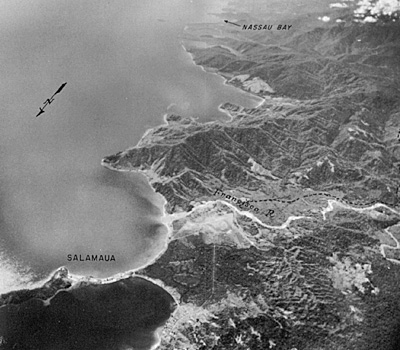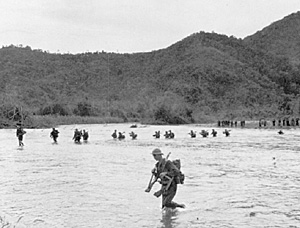1 July to 12 September 1943
 SALAMAUA, objective of the attack.
SALAMAUA, objective of the attack.
During July and August, while the various headquarters of the Southwest Pacific Area were preparing plans and assembling troops and supplies for the Lae-Markham Valley invasions, and while the air and naval forces were attacking Japanese aircraft, bases, and lines of communication, the troops in front of Salamaua were carrying out their part of the plan by the diversionary attack against that port. (Unless otherwise indicated this section is based on McCartney, The Jungleers, Ch. VII; ALF, Rpt on New Guinea Opus: 1 Mar-13 Sep 43; 162d inf Rpt of Opus, and Jul; 41st Div Arty, Hist of Salamaua Campaign, 23 Apy-4 Oct 43; Combined Operational Int center GHQ SWPA, Resume of Allied Mil Opus and Int Leading to the Capture of Lae and Salamaua From the Enemy: Jun-Sep 43, 20 Sep 43, in GHQ SWPA Jnl, 20 Sep 43.)
Starting from the arc-shaped positions they held in early July, the 3d Australian Division and the MacKechnie Force, soon joined by the remainder of the 16.-d Infantry, fought their way forward until by the end of August they were closing in on the town and airfield of Salamaua. (See Map 6.)
At first the reinforced 1st Battalion, 162d Infantry, fighting on the right of the 3d Australian Division, was the only American unit present, but this force was enlarged in July, after the capture of Bitoi Ridge, when other elements of the 41st Division were attached to the 3d Australian Division. This attachment came about because more U.S. infantrymen and artillerymen were needed to secure the Tambu Bay-Dot Inlet area northwest of Nassau Bay, and because a supply base for Australians and Americans in the combat area was required. Consequently the Coane Force, commanded by Brig. Gen. Ralph W. Coane who was also 41st Division artillery commander, was organized during the second week in July. (It consisted at first of the 2d and 3d Battalions, 162d Infantry; the 162d Infantry Cannon Company; 3d Platoon, Antitank Company, 162d Infantry; C Battery, 2o9th Coast Artillery Battalion; A Battery, 218th Field Artillery Battalion; A Company, 116th Medical Battalion; A and D Companies, 532d Engineer Boat and Shore Regiment, 2d Engineer Special Brigade; A Company, Papuan Infantry Battalion; a Combined Operational Service Command detachment; Troop D, 2/6th Royal Australian Artillery Regiment; and signal and quartermaster troops.)
The MacKechnie Force, then fighting forward from Bitoi Ridge, was not a part of the Coane Force. Some units assigned to the Coane Force were already in the Nassau Bay area; others soon came up from Morobe. (Problems involving command over the mixed Australian-American units appear to have been additional factors in the decision to create the Coane Force rather than to turn all American troops over to Colonel MacKechnie. The MacKechnie Force was attached to the 3d Australian Division, but Maj. Gen. Horace H. Fuller, commanding the 41st U.S. Division, retained control over the American troops at the actual beachhead. Thus, as he put it later, Colonel MacKechnie was "placed in the unenviable position of trying to obey two masters" who kept giving him conflicting orders, The impossibility of obeying them both finally led MacKechnie to request relief as commanding officer of the 162d. He was reassigned as Coane Force S-3, and later a's liaison officer with the 3d Australian Division, but returned to command the 162d On the dissolution of the Coane Force. See Ltr, Col MacKechme to Gen Smith, Chief of Mil Hist, 2 Nov 53, no sub, OCMH.)
Both Coane and MacKechnie Forces fought under command of General Savige, commanding the 3d Australian Division, and after Savige's headquarters was relieved on 24 August by Headquarters, 5th Australian Division, under command of Maj. Gen. E. J. Milford, the Americans served under Milford. At the same time Col. William D. Jackson, 41st Division artillery executive officer, was appointed as Commander, Royal Artillery, of the .3d and then the 5th Australian Divisions. Jackson, using a cornposite Australian and American staff, served as artillery commander until the end of hostilities in that area.
On 17 July the Coane Force moved forward from Nassau Bay, and by the end of the next day had secured the southern headland of Tambu Bay, where a supply base was set up. Starting on 20 July, the Americans launched a series of attacks with strong artillery support which resulted on 13 August in the capture of the high ground--Roosevelt Ridge, Scout Ridge, and Mount Tambu--overlooking Tambu Bay and Dot Inlet. On 12 August the Coane Force was dissolved and the entire 162d Infantry reverted to Colonel MacKechnie's control.
At the same time the Australians pressed forward so that by the first week in September they had reached the Francisco River, which flows in an west-east direction just south of the Salamaua airfield. All advances were made up and down precipitous ridges varying from eight hundred to three thousand feet in height. With characteristic skill the Japanese had established strong defensive positions on the ridges; there were many automatic weapons emplacements, with earth-and-log pillboxes predominating, that gave each other mutual support with interlocking bands of fire. Trenches and tunnels connected the emplacements.
Early September saw Japanese resistance slackened. On 11 September the Australians and the 162d Infantry Reconnaissance Platoon crossed the rain-swollen Francisco River and by the end Of 12 September the airfield, the town, and the entire isthmus, which had been held by the Japanese for eighteen months, was back in Allied hands.
 CROSSING RAIN-SWOLLEN FRANCISCO RIVER
CROSSING RAIN-SWOLLEN FRANCISCO RIVER
The cost was not cheap. On 29 June there were 2,554 men in the 162d Infantry. By 12 September battle casualties and disease had reduced the regiment to 1,763 men. One hundred and two had been killed, 447 wounded. The 162d estimated it had killed 1,272 Japanese and reported the capture of 6 prisoners.
The Japanese had lost Salamaua after a stiff fight and the very strength of their defense had played into Allied hands, for of the ten thousand enemy soldiers in the Lae-Salamaua area, the majority had been moved to Salamaua. The Allied ruse had succeeded.
More Markham Valley and the Huon Peninsula
- Plans: US and Japanese
Allied Air and Naval Preparations
The Salamaua Attack
Lae: The Seaborne Invasion
Nadzab: The Airborne Invasion
Strategic Reconsiderations
The Coastal Advance
Jumbo Map: The Huon Peninsula (monstrously slow: 611K)
Back to Table of Contents -- Operation Cartwheel
Back to World War Two: US Army List of Issues
Back to MagWeb Magazine List
© Copyright 2002 by Coalition Web, Inc.
This article appears in MagWeb (Magazine Web) on the Internet World Wide Web.
Other military history articles and gaming articles are available at http://www.magweb.com